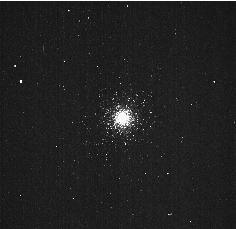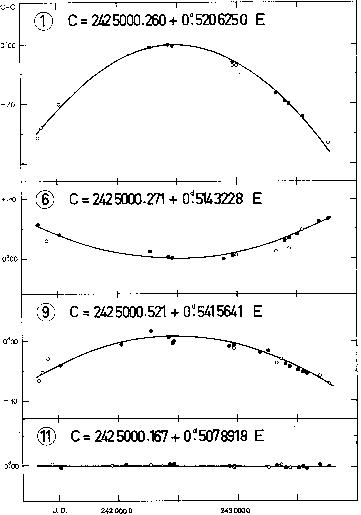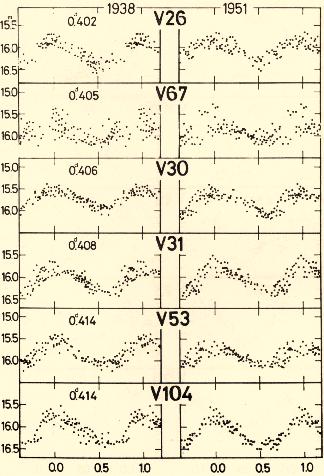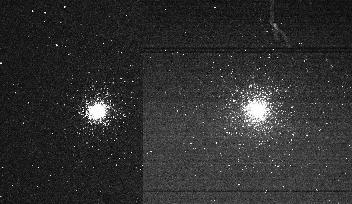Katalin Barlai
Konkoly Observatory of the Hungarian Academy of Sciences
In the last years of the XIXth century Solon I. Bailey made photographic observations at Arequipa, Peru, at the observational station of the Harvard Observatory. He obtained long series of photographs on M3, M5, and {omega} Cen clusters and discovered hundreds of RR Lyrae variables on them.
About four decades later (1938) W. Christian Martin found increased periods based on new plates taken of {omega} Cen. This result made further research promising. They brought up the idea to grasp stellar evolution through period changes.
In Budapest the photographic observations of globular clusters span
almost 30 years (1937-1966) (Fig. 1). These observations have been
initiated by L. Detre. In the beginning he took the considerable part
of plates at the Newtonian focus of the Observatory's 24" telescope. Later the program was continued by the staff members of the observatory. Júlia Balázs-Detre, Tibor Herczeg, György Kulin, Miklós Lovas, Béla Szeidl, and the author participated in the observations.
The globulars M3, M5, M15, M56, and M92 have been photographed systematically. The contribution by G. Kulin and M. Lovas has been extremely high to this plate collection. Apart from a few Kodak products and Agfa Astro special plates, the majority of the plates used were Guilleminot Superfulgur. With a few exception, exposition times extended 10-20 minutes. In course of these three decades hundreds of plates have been obtained on the clusters mentioned above.
In order to study the period changes, mean light curves and O-C
diagrams have been constructed. Studies of this type have been
published on about 60 RR Lyrae variables in M3 by István Ozsváth
(1957) and 21 variables in M15 by Imre Izsák (1957). Further studies
based on Budapest plates of M3 concerning 112 measurable variables were carried out and published (Szeidl, 1965) (Fig. 2). Later
data on 54 RR Lyrae stars in the cluster M15 were published by
the author (Barlai, 1989) (Fig. 3).
It is worth mentioning that the brightness of overwhelming
majority of the RR Lyrae variables in M5 have been measured or
estimated by M. Lovas. This database is to be analysed.
In 1975 a new 1-meter RCC telescope was installed at our
Piszkéstetö mountain station. Since then the photographic
observations have continued there until the beginning of the 1990s.
Several hundreds of plates have been obtained on M3, M5, and
M15 globular clusters. Due to the better resolution, further details
can be revealed on the variables closer to the dense central region
or the ones having close companions on the plates taken in
Budapest with the Newtonian telescope. Analysis of their data means
a task for the future.
Although the study of period changes did not fulfill the original
expectations to show immediately the direction of cluster evolution
still they and the numerous brightness data obtained gave us a
deeper insight into the nature of RR Lyrae stars.
The new CCD technique made further photographic observation of
globular clusters obsolete (Fig. 4). This ``old'' plate material, however, means a base for new approaches to these fascinating objects.
Barlai, K., 1989, Mitt. Sternwarte Budapest, 92, 143
CoKon92
Izsák, I., 1957, Mitt. Sternwarte Budapest, 42, 63
CoKon42
Ozsváth, I., 1957, Mitt. Sternwarte Budapest, 42, 81
CoKon42
Szeidl, B., 1965, Mitt. Sternwarte Budapest, 58, 1
CoKon58
P.O. Box 67, H-1525 Budapest, Hungary 


